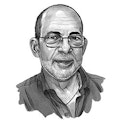I started writing this almost two months ago while still deep in treatment as an inpatient for my stem cell/bone marrow transplant.
The reason for not submitting it earlier is insecurity. Is this relevant? Will it resonate? Is it something I really want to share? Will you relate to what I’ve written?
You vacillate between honing your message and relegating it to the file of scraps you have hidden away in a dark corner of your computer’s hard drive. That’s what I did for over two months as I continue to recover. Then, it occurred to me I might really be on to something.
What I discovered was observational therapy and this is how it has changed my life.
If you’ve been keeping up with my personal odyssey and the challenges that accompany it, you already know that I am currently an inpatient at the City of Hope in Duarte, Calif. Being an inpatient isn’t the most taxing physical job I’ve ever had, but it does bring with it a unique set of mental and physical challenges that are hard to transcend.
This is the 18th day of the 30 I will be confined to my room. It is T+13—thirteen days after being infused with my donor’s stem cells: 5,350,000 per kilogram of my bodyweight.
Post-transplant, the rules become much more stringent, especially if you’re not a big fan of day or nighttime television. You can read and I came prepared to do just that, or you can get lost in the constantly expanding world of audiobooks, podcasts and tapes. The truth is, once begun, there are large chunks of time you really don’t feel like doing much of anything and that can be a problem.
Fortunately, years of writing has helped me hone my skills as an observer. In my case, it’s been a lot. Everything from all the therapies—art, recreational, occupational and physical—to just about everything else going on around me in the course of a “normal” day.
It’s become so engrossing I’ve actually given it a name and included it in the list above. I call it “observational therapy,” and it focuses on everything we experience. Admittedly, the implications and impact of observational therapy are exaggerated when you are facing your own mortality. But they are every bit as consuming when we’re observing the more mundane elements of everyday life swirling around us as we (attempt to) go peacefully and quietly through the world.
Recognizing how important—and, powerful—it is to understand everything about my illness and, now, my recovery, observational therapy may be the most critically important therapy of them all, considering it takes the least amount of instruction and guidance.
In fact, all it takes is awareness and the desire to see what is going on around you. For me, it started with being so ill, all I could do was watch and listen. It began with recognizing the elegant grace and care everyone brought to my care.
It was observing the bone marrow transplant nurses interacting with nursing the interns from three of the universities close to the City of Hope; the importance they placed on not only showing these kids the how of what they would be asked to do, but also the time they spent demonstrating and explaining the why of what they would be doing.
It was a view of the San Gabriel Mountains visible from my window or a wave from another patient as we got our daily exercise in walking the ward. It was the true joy the other therapist’s derived from the genuine connections they forged with all of us entrusted to their care.
Now, more than two months later, as an outpatient, it is the beauty of the yucca trees that filled the San Gabriel Mountains or the jacarandas in full bloom in the hills near the hotel. It is friends driving the hour or more to donate blood and platelets and their willingness to hang out and make sure we’re still OK. It’s watching our grandkids play in the pool here at the hotel or at a nearby park. The messages from long-lost friends and acquaintances.
It is gradually re-entering the beauty of a “normal” life and the ability to observe the beauty of what that really means.
About the Author

Mitch Schneider
Mitch Schneider is a fourth-generation auto repair professional and the former owner of Schneider’s Auto Repair in Simi Valley, Calif. He is an industry educator, seminar facilitator, blogger, and author of the acclaimed novel Misfire.
